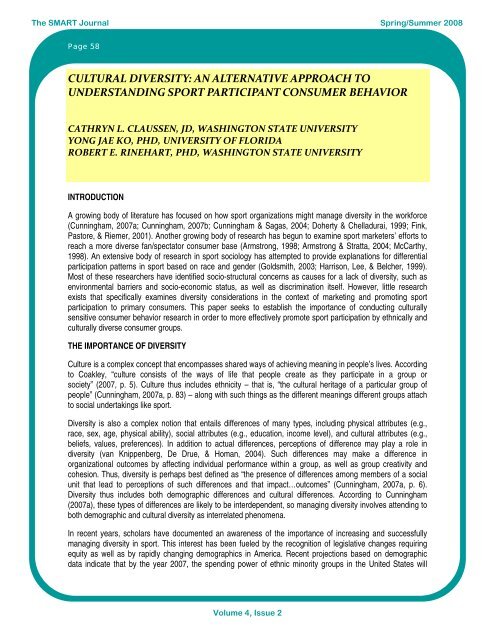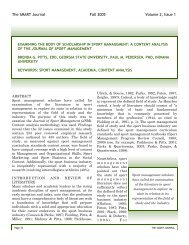Spring/Summer 2008 Volume 4, Issue 2 - The SMART Journal
Spring/Summer 2008 Volume 4, Issue 2 - The SMART Journal
Spring/Summer 2008 Volume 4, Issue 2 - The SMART Journal
You also want an ePaper? Increase the reach of your titles
YUMPU automatically turns print PDFs into web optimized ePapers that Google loves.
<strong>The</strong> <strong>SMART</strong> <strong>Journal</strong> <strong>Spring</strong>/<strong>Summer</strong> <strong>2008</strong><br />
Page 58<br />
CULTURAL DIVERSITY: AN ALTERNATIVE APPROACH TO<br />
UNDERSTANDING SPORT PARTICIPANT CONSUMER BEHAVIOR<br />
CATHRYN L. CLAUSSEN, JD, WASHINGTON STATE UNIVERSITY<br />
YONG JAE KO, PHD, UNIVERSITY OF FLORIDA<br />
ROBERT E. RINEHART, PHD, WASHINGTON STATE UNIVERSITY<br />
INTRODUCTION<br />
A growing body of literature has focused on how sport organizations might manage diversity in the workforce<br />
(Cunningham, 2007a; Cunningham, 2007b; Cunningham & Sagas, 2004; Doherty & Chelladurai, 1999; Fink,<br />
Pastore, & Riemer, 2001). Another growing body of research has begun to examine sport marketers’ efforts to<br />
reach a more diverse fan/spectator consumer base (Armstrong, 1998; Armstrong & Stratta, 2004; McCarthy,<br />
1998). An extensive body of research in sport sociology has attempted to provide explanations for differential<br />
participation patterns in sport based on race and gender (Goldsmith, 2003; Harrison, Lee, & Belcher, 1999).<br />
Most of these researchers have identified socio-structural concerns as causes for a lack of diversity, such as<br />
environmental barriers and socio-economic status, as well as discrimination itself. However, little research<br />
exists that specifically examines diversity considerations in the context of marketing and promoting sport<br />
participation to primary consumers. This paper seeks to establish the importance of conducting culturally<br />
sensitive consumer behavior research in order to more effectively promote sport participation by ethnically and<br />
culturally diverse consumer groups.<br />
THE IMPORTANCE OF DIVERSITY<br />
Culture is a complex concept that encompasses shared ways of achieving meaning in people’s lives. According<br />
to Coakley, “culture consists of the ways of life that people create as they participate in a group or<br />
society” (2007, p. 5). Culture thus includes ethnicity – that is, “the cultural heritage of a particular group of<br />
people” (Cunningham, 2007a, p. 83) – along with such things as the different meanings different groups attach<br />
to social undertakings like sport.<br />
Diversity is also a complex notion that entails differences of many types, including physical attributes (e.g.,<br />
race, sex, age, physical ability), social attributes (e.g., education, income level), and cultural attributes (e.g.,<br />
beliefs, values, preferences). In addition to actual differences, perceptions of difference may play a role in<br />
diversity (van Knippenberg, De Drue, & Homan, 2004). Such differences may make a difference in<br />
organizational outcomes by affecting individual performance within a group, as well as group creativity and<br />
cohesion. Thus, diversity is perhaps best defined as “the presence of differences among members of a social<br />
unit that lead to perceptions of such differences and that impact…outcomes” (Cunningham, 2007a, p. 6).<br />
Diversity thus includes both demographic differences and cultural differences. According to Cunningham<br />
(2007a), these types of differences are likely to be interdependent, so managing diversity involves attending to<br />
both demographic and cultural diversity as interrelated phenomena.<br />
In recent years, scholars have documented an awareness of the importance of increasing and successfully<br />
managing diversity in sport. This interest has been fueled by the recognition of legislative changes requiring<br />
equity as well as by rapidly changing demographics in America. Recent projections based on demographic<br />
data indicate that by the year 2007, the spending power of ethnic minority groups in the United States will<br />
<strong>Volume</strong> 4, <strong>Issue</strong> 2








